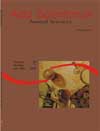<b>Performance, carcass characteristics and chemical composition of nonpregnant or pregnant heifers finished in feedlot</b> - DOI: 10.4025/actascianimsci.v29i4.1010
Abstract
This work was carried out to study the effect of pregnancy on performance, carcass characteristics and chemical composition of crossbred heifers in comparison with nonpregnant heifers finished in feedlot. Five pregnant heifers and five nonpregnant heifers, 20 months old and with initial live weight of 327 kg were used. The initial live weight, final weight, average daily gain, intake, feed conversion, carcass weight, hot carcass dressing, Longissimus area and fat thickness (4.21 mm) did not differ (p > 0.05) between treatments. Pregnant heifers chuck showed higher levels (p < 0.05) of moisture and ash, and lower levels (p < 0.05) of total fat, than nonpregnant heifers. Pregnant heifers rump showed higher levels (p < 0.05) of moisture. Nonpregnant heifers striploin had the highest level (p < 0.05) of moisture. The fatty acid profile of pregnant heifers chuck had the highest levels (p < 0.05) of 14:0, 16:1n7 and 20:4n6, but showed the lowest level (p < 0.05) of 17:0. Nonpregnant heifers topside showed the highest levels (p < 0.05) of 18:1t11 and 18:2c9t1. Pregnant heifers chuck showed the highest level (p < 0.05) of PUFA. Nonpregnant heifers had higher levels of n-6 fatty acids than pregnant heifers. The striploin of pregnant heifers showed higher percentage (p < 0.05) of n-3.Downloads
Download data is not yet available.
Published
2008-03-06
How to Cite
Macedo, L. M. A., Prado, I. M. do, Ducatti, T., Prado, J. M. do, Matsushita, M., & Prado, I. N. do. (2008). <b>Performance, carcass characteristics and chemical composition of nonpregnant or pregnant heifers finished in feedlot</b> - DOI: 10.4025/actascianimsci.v29i4.1010. Acta Scientiarum. Animal Sciences, 29(4), 425-432. https://doi.org/10.4025/actascianimsci.v29i4.1010
Issue
Section
Ruminant Nutrition
DECLARATION OF ORIGINALITY AND COPYRIGHTS
- I Declare that current article is original and has not been submitted for publication, in part or in whole, to any other national or international journal.
The copyrights belong exclusively to the authors. Published content is licensed under Creative Commons Attribution 4.0 (CC BY 4.0) guidelines, which allows sharing (copy and distribution of the material in any medium or format) and adaptation (remix, transform, and build upon the material) for any purpose, even commercially, under the terms of attribution.
Read this link for further information on how to use CC BY 4.0 properly.
0.9
2019CiteScore
29th percentile
Powered by 








































